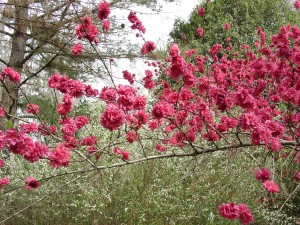People think peaches grow only in Georgia. A decade long period of mild winters in the Southern Appalachian region (USDA zones 6 and 7) have increased gardener confidence in growing peaches. Peaches (Prunus persica) tend to flower in early spring, when the threat of spring frost is high across the region. In many years spring frost may kill 80% of their flower buds, but still manage to produce a full crop in July or August.
Standard peach trees grow and are easily maintained through pruning at 10-12 feet in height. Do not plant dwarf peach trees as they live only a short time and are not worth their cost. Dwarf root systems for peaches are weak and break off from the graft union within a few years.
Select only cold hardy, great tasting peach varieties. The finest freestone peach varieties with long winter chilling requirement are listed below. If you garden in zone 7-a or further north, these are suited for your area. Freestone peaches are great for eating, baking and canning; the flesh does not stick to the pits. Clingstone peaches are also sweet and tasty.
Table 1. New peach varieties and approximate harvest times in East Tennessee and Southwest VA (zone 6-b):
3rd week July Contender (yellow flesh, freestone)
4th week July Nectar (white flesh, freestone)
1st week August Carolina Gold (yellow flesh, freestone)
2nd week August China Pearl (white flesh, freestone)
Late August Intrepid (yellow flesh, freestone)
Table 2. Older reliable varieties for East Tennessee and Southwest Virginia include:
Cresthaven (medium to large fruit, yellow flesh, freestone)
Jefferson (early season, medium yellow-orange flesh, freestone)
Monroe (late harvest, medium yellow flesh, freestone)
Red Haven (medium, nearly fuzzless, yellow flesh, freestone)
Credit: Dr. David Lockwood, Extension Fruit Specialist at the Universities of Tennessee and Georgia, recommends these varieties.


 Posted in
Posted in 
